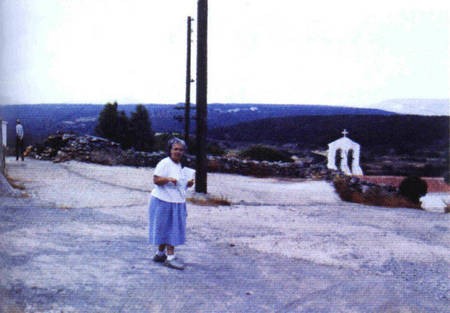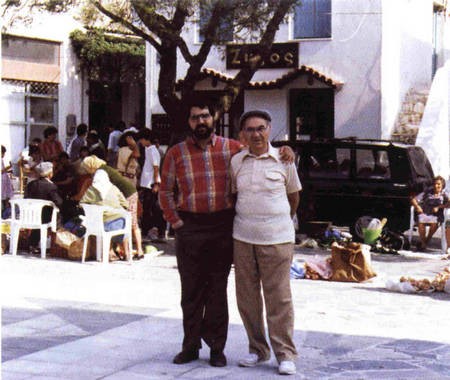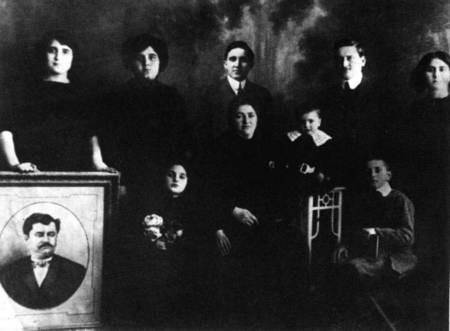The quest for the well of sweet water
By, Jennie Vlanton
Homecomings section, Odyssey Magazine.
May/June 2006 Odyysey, pp.102-103
http://www.odyssey.gr/
Jennie Vlanton, a retired public school teacher, lives with her husband Elias in Kent, Ohio. Married in 1947, they have two children [both educators] and six grand-children. Jennie is a member of the Annunciation Greek Orthodox Church in Akron, Ohio. For more of her stories about growing up Greek-and-American in St. Louis, Missouri, visit Jennie's website at
http://www.vlanton.com/

Elias Vlanton, and Elias Vlanton, father and son, in Potamos, Kythera
As far back as I can recall, born and raised in St. Louis, Missouri, and as a child until I became an adult, I heard about a place called Cerigo, (modern-day Kythera). My parents were both born and raised in Smyrna. Asia Minor, and yet I recall my mother telling my sister and brothers and me that her family had originally come to Smyrna trom Cerigo. Her maiden name had been Glitsos. Those facts intrigued me. Wnat was this place called Cerigo? Where was it? Would I ever be able to find and visit the village of my ancestors on Cerigo?
My parents had friends who were Smyrniotes, and some who were Cerigotes, from the island of Cerigo, but that had no significance for me.
After teaching in the St. Louis Public Schools for thirty years I retired from that profession. Then in my early seventies, a decision was made in the summer of 1995, for my husband Elias and I to take another trip to Greece. This would be our third trip there, and it was always an invigorating experience to visit family, and see the glories of ancient Greece. We would have with us our grandchildren Joanna and Elias. Joanna was going to Thessaloniki for a semester to attend Anatolia College. Added to the pleasure of our trip, we would meet up with our son Elias with his wife Jane and son Ari, also there.
In making our plans for our trip to Greece. I began to think about Cerigo. Again, where was it? After a little research, and help from my son who was able to get me several books, in English and in Greek, I learned Cerigo was one of the Greek lonian islands in the Mediterranean Sea. I also learned that the name Cerigo is Venetian. From roughly the year 1207 to the year 1797, the island was mainly under Venetian rule. After 1797. for short periods of occupation, Cerigo was under French. and then Turkish rule. In 1814, the island officially came under the protection of Great Britain. Finally. in 1864, Cerigo was ceded to Greece, and the island received the Greek name of Kythera.
Oftentimes I had thought that it would be interesting to visit Cerigo. The only family information my mother recalled was that her grandfather had been a priest in Smyrna. but never mentioning when, or how many generations before, the first Cerigoti ancestor had come to Smyrna. It was obvious no one had that information either. My mother said that the family name was not originally Glitsos. However, she had been told by family members the name Glitsos derived from a natural occurrence in the area. something about water. some kind of water. She used the term glikó pigathi (translated into well of sweet water), that would be the clue, our key to solve the family mystery.
I went back to studying the books carefully, and I discovered that today there were two villages with Glitsos inhabitants. One of the passages mentioned a village called Dokana. It said it was unknown why the village received that name, but that the first residents had the surname of Glitsos, since the days of the priest Gregory Logotheti about the year 1797.
How Dokana got its name?

Jennie Vlanton visited Dokana,seeking traces of Evangelia Glitsos Constantinides.
The other village that mentioned Glitsos residents was Kipriotianika. The book explained that the village was first called Thrimonari, taking its name from the topography of the area It originally had residents from the island of Cyprus, and later residents with the name of Glitsos arrived. Armed with this information, and a map of the island of Cerigo. I felt we were ready to discover my Cerigo Kytherian roots.
[Ed - there are numerous other entries about members of the Glytsos family at kythera-family. Search under Glytsos.]

Glytsos family. Photo from Jennie Vlanton's collection of family photo's.
This seemed like an adventure finally coming true! I was excited, and so was the rest of our group. Arriving, we headed for the village of Potamos, which was to be our base. I was immediately delighted and enchanted by it. The village held a warmth, charm and happiness for me.
Our pension was an old building that been renovated and remodeled a few years before. From the street we entered a courtyard that had chairs and several tables with umbrellas. There was a whitewashed wall shelding the patio from the street, about eight feet high.
The pension was a short walk to the village center, less than half a city block. There was a covered pavilion, with tables and chairs for dining there. We had most of our meals there, unless our son drove our group to a restaurant in another village A charming church was situated by the pavilion, and we were surprised to see women we had seen a few days before in their work clothes, barely recognizable, a complete transformation, to b wearing their Sunday best, attending Sunday services. Cars were parked and lined on both sides of tne pavilion. Small stores, a bakery, a restaurant, a grocery store, the post office, and the ever-present coffeehouse were located on one side of the street. Everywhere we went, everyone we met, were extremely friendly and courteous, like old friends.
Ever-adventurous, our son Elias had the rented car, and he was able to take Jane and the children sightseeing to many parts of the island. They gladly went sightseeing, to the capital of Kythera, called Hora; also to a nearby castle, among other places. I chose not to go with them. I didn’t want any distraction to keep me from my mission; to find the village of my Kytherian roots.
Since we were unfamiliar with the island. we needed a guide to help us maneuver the various paths to achieve our goal. We were fortunate that we had made the acquaintance of Theodoros, who was very familiar with the island of Kythera . He had formerly had the job of refuse collector for the whole island. His job involved driving a tractor, collecting the trash. He knew practically everyone on the island. I was elated. I hoped he might know someone living there by the name Glitsos.
The day came when I was to begin my search to find my Kytherian roots, I was very excited. Could it be, after all those years, I would find the ancestral home of the Glitsos family? Would there still be the gliko pigathi after all those years? Would anyone recognize such a water well existed in this modern day? If I did find any Glitsos native, I reasoned I would start my search by asking if certain names sounded familiar; Kosta and Yanni. My mothers father, my grandfather. was named Kosta. He bad named his first born son Yanni. I reasoned that must have been the name of Kosta's father, if Kosta followed Greek tradition in naming his first-born son after his own father.
My search for my Glitsos ancestry started on a day when the sun was shining, beautiful summer weather, a good omen for me. My son Elias was going to drive us; Theodoros, our guide, my husband Elias and me We were to start first in the village of Kyprianika.
The village of Kyprianika was almost deserted, it had about seven inhabitants in all. We asked one man we met for directions. He directed us to a man named Stelios, across the street from where we were. The stranger invited my husband to sit outside in the front of his home, in the shade. The man showed typical Greek hospitality, offering my husband a drink; he accepted ouzo, while his host drank whiskey. In the meantime, Stelios. whose
home we had been directed to, welcomed us into his home. It was very neat and clean. Stelios was a widower. He had been watching a program on the television. He informed me there was no gliko pigathi in that village. He could not make any connection with the names of Kosta and Yanni, although he did mention that he knew of a Kosta Glyson [Glitsos], who had a brother, George Glyson, living in Australia. He mentioned that the young people did not stay in the village, so many left searching for opportunities elsewhere, Australia being a popular choice. Of course, this was a temporary dead-end in my quest.
The search for the Glitsos relatives continued when we drove to the village of Dokana. Theodoros took us to see a woman whom he knew whose maiden name had been Glitsos. She was a very kind sympathetic woman. She couldn’t help us, but directed us to another house, where another couple by the name of Glitsos lived. Theodoros took us there.
I was carrying a large white envelope with me, with all my notes and information. When the gentleman came to the door to speak to us, he noticed my envelope. I told him I was from America. When I inquired about the Glitsos family. his immediate reply was to ask me if I was going to file a claim of inheritance. I was astonished. I said no. I was just trying to trace the origin of my family By this time. we nad moved to the street, in front of his house.
I asked him if there was a gliko pigathi in the area. He resoonded by saying. and waving his arms, ' Yes, yes we have several wells of gliko nero'. At that moment, I knew that the two words my mother had repeated so often, gliko pigàthi, were enough to help me find my Kytherian roots.
However, connecting the names Kosta and Yanni, and establishing the number of years before that the family had been in Kythera would prove to be more difficult. Our informant directed us to the home of Alecos Glitsos. We found the house, and Alecos insisted we go into his home, because by then the day was getting much warmer. Alecos had been a farmer but self-educated He was a gracious host, and insisted on serving us the traditional glass of water with a teaspoonful of vanilla in the glass. In a cabinet in his living room. there was a copy of Gone With the Wind in Greek.
Alecos had a brother named Kosta but there was no Yanni in their family. He could not make a connection of the two names Kosta and Yanni.
An unexpected development in Dokana was tne discovery of the Glitsos mansion. We drove a short distance there, and saw it. It was a rural mansion, that in the days it was built was used for summer vacations and for the control and gathering of the produce from the noble's fields. It had a fortress-like character. The main house had a rectangular floor plan, with walls that appeared thicker at the base. There was a large courtyard with outbuildings. enclosed by a high wall. The outside of the mansion looked very well taken care of. I was speechless. I never anticipated an ancestor of mine, on a small island, could have achieved so much to have built such a home.
We left the village of Dokana and headed for Potamos to take Theodoros home. I thanked him for being such a good guide in helping me in my search of the Glitsos family. I couldn’t believe there were so many people who had the surname of Glitsos. It certainly was not a common name in the United States. I had never met anyone in America with that name who wasnt a relative.
I felt we had finally achieved my dream. I had found my Kytherian roots. Cerigo was a wonderful dream come true. I am eternally grateful to my son Elias for his invaluable help and patience to make my dream come true.